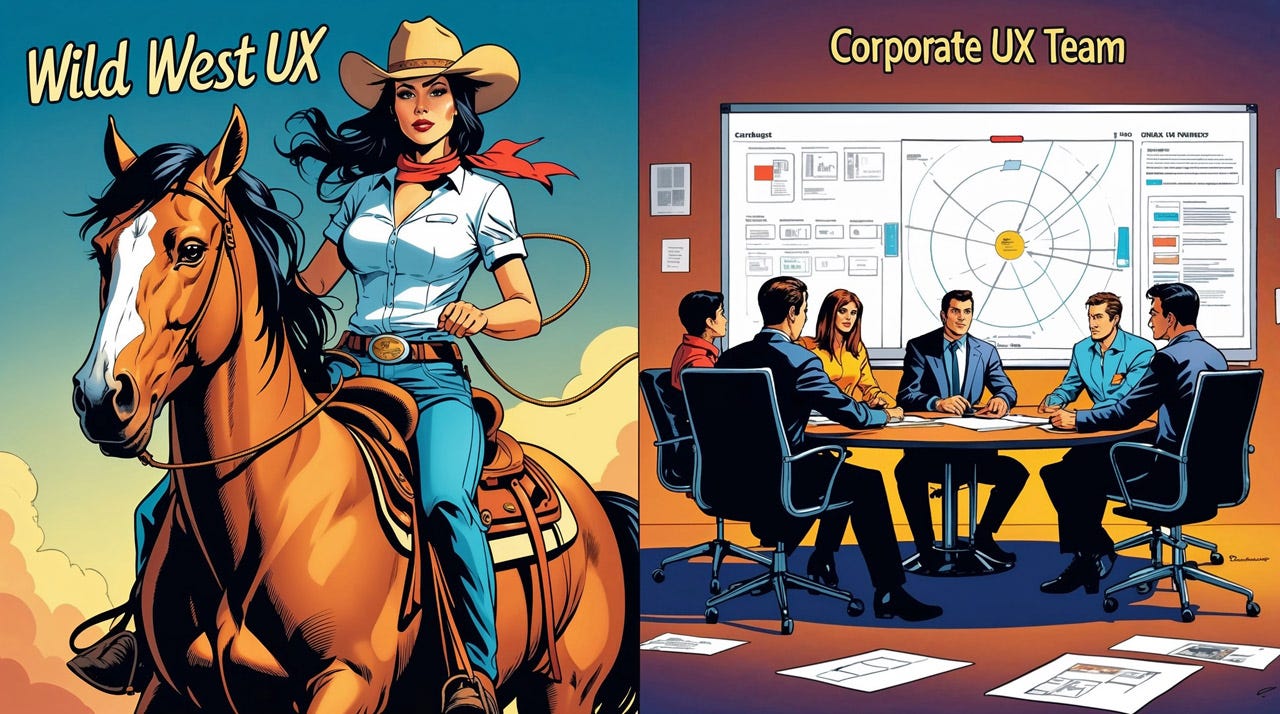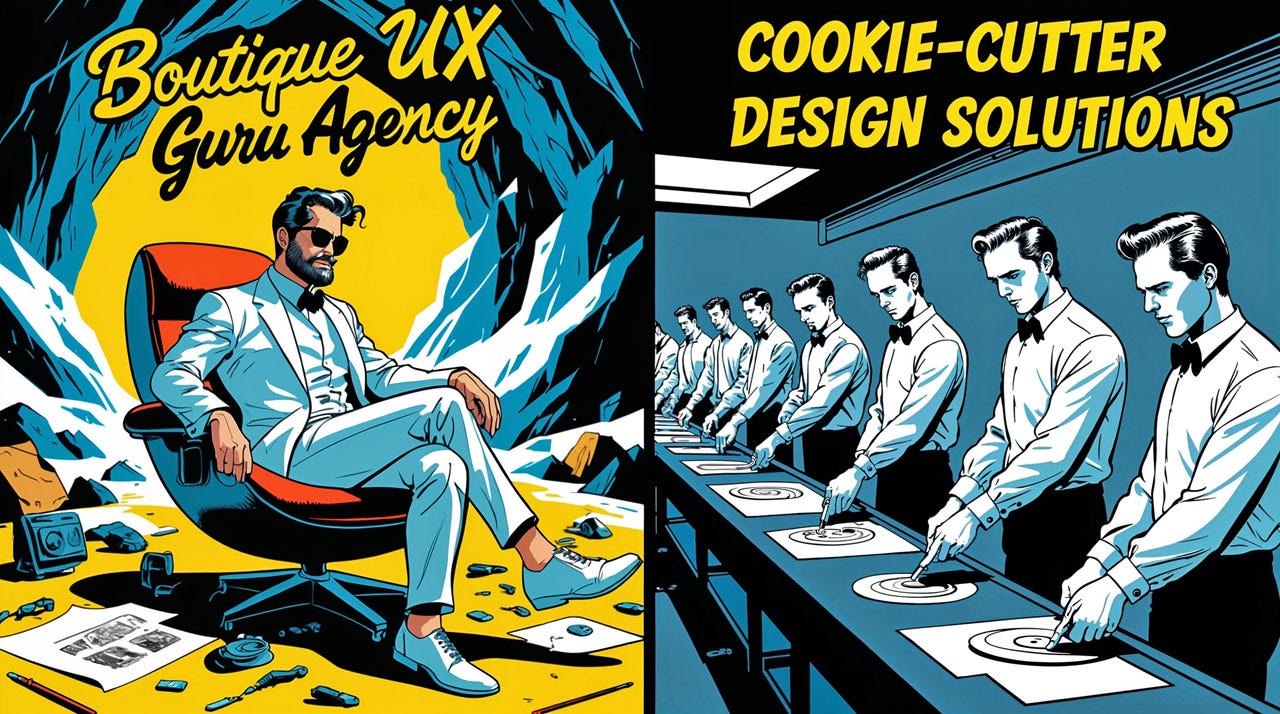Summary: Rapidly increasing in-house UX maturity coupled with AI’s productivity explosion threatens the survival of UX consultancies and design agencies. Major downsizing is imminent for many agencies. Survive by either offering highly specialized, strategic consulting or becoming a provider of automated, scalable design. The window to adapt is closing.
Brace yourself, UX processes are evolving fast. Mid-sized agencies? Toast. But here’s the upside: carve a niche, master AI, and thrive. Innovators will ride the AI wave; optimizers will refine it. This isn’t doom — it’s your chance to lead. Adapt, specialize, and own the next chapter.
I recently sat down with Andras Rung, founder of the design agency Ergomania, and we had a very frank discussion about the future of UX agencies. And frankly, if you work in a UX consultancy or agency right now, you might want to sit down for this.
I made a bold claim: UX agencies with more than 10 people have no future. Even midsize firms will need to shrink dramatically. Why? Companies in wealthy nations are rapidly building in-house UX teams, reducing reliance on external agencies. We’ve already seen giants like IDEO cut staff by a third, and this trend will accelerate. The golden age of sprawling UX consultancies is over.
Before everyone starts sharpening their pitchforks, let me explain why I said this, because it's not just some random doomsday prediction. It's based on two massive trends colliding: the increasing maturity of UX as a discipline, and the AI revolution.
UX consultants may be about to join the milkman and the typing pool as exhibits in the Museum of Extinct Professions. (Leonardo)
UX is Growing Up (Finally!)
For decades, UX was the Wild West. Companies barely understood what it was, let alone how to do it. Consultants thrived because businesses needed external expertise just to figure out basic usability. But things are changing. More and more companies, even smaller ones, are building in-house UX teams. They're realizing that good UX isn’t a luxury; it’s essential. And guess what? They're starting to get pretty good at it themselves. This internal talent development pipeline will only accelerate, especially in wealthier countries.
The past of UX was the Wild West, where lone-ranger UX consultants rode to the rescue and roped in a few user findings, which were like gold dust for companies disconnected from their customers. The future of UX will be very corporate as user-centered design becomes the standard way of doing business. Any decent company will have sufficient in-house designers and researchers who won’t want those cowboy and cowgirl UX consultants. (Leonardo)
In-House Teams Will Dominate (But Talent Gaps Remain)
Companies will increasingly “own” their UX, embedding designers across departments rather than siloing them. This pancaking of UX roles will boost maturity but poses a hiring challenge: How do you recruit senior talent when your team is junior?
For the next 20 years, there’s a window for specialized UX recruiters to bridge this gap. But as in-house teams mature, they’ll eventually outgrow the need for external help, except for strategic jolts of creativity.
The Polarization of the UX Market
The middle class of UX agencies will vanish. Success will cluster at the extremes:
High-end boutiques: Offering strategic, senior-level consulting for companies with mature in-house teams. These firms will challenge internal biases and drive innovation, by limiting themselves to guru-level staff who are true thought leaders and not simply compilers of best practices. (Clients will get those from Deep Research and its ilk, not from hiring consultants or taking training courses.)
Low-end providers: Delivering cookie-cutter solutions for small businesses (e.g., dentists, local restaurants) via AI-powered design systems.
Two approaches that’ll work for UX consulting in the future. The high end may get the glory, but there will be many more low-end providers. (Napkin)
Mid-sized agencies? They’ll struggle unless they niche down or fragment. The days of “one-size-fits-all” UX services are numbered. (And while working in a high-end boutique may sound exciting, there will be about a hundred in the world, with no more than 10 people per boutique, meaning that they will provide 1,000 jobs. This is what it should be because working at the “guru level” requires people to be in the top 0.1%, of which there are only a few thousand people in the entire UX profession, and most of them will want to work in AI startups or lead the few remaining big enterprise teams.)
Bifurcating future for UX agencies: the world’s top-1,000 UX gurus will work in 10-person thought-leader boutiques, while masses of low-paid designers will crank out mass-produced designs for small clients. Most UX professionals are too stupid to be gurus and too smart to cut cookies, meaning they will get non-agency jobs, of which there will be plenty. (Leonardo)
AI is the Productivity Game Changer
The real kicker is AI. 2023 was effectively “Year 1” in the generative AI era; as of 2025, we’re still only in “Year 3.” Let me be clear: we are in a revolution. Forget incremental improvements; we're talking about a fundamental shift in our work. I believe we're looking at a tripling of productivity in UX within the next decade thanks to AI. Programmers? Hold on to your hats — they will gain a tenfold productivity increase!
Think about that. One UX professional in ten years will do the work of three today. Suddenly, those big teams start to look incredibly inefficient. All that management overhead, all those meetings, all that internal friction… AI is going to make smaller teams not just viable, but superior.
The UX Profession’s Industrial Revolution
I compared this shift to Henry Ford’s assembly line. When cars became affordable, entire ecosystems (mechanics, gas stations, highways) emerged. Similarly, as AI makes UX cheaper and faster, demand will explode. New roles and industries will form — ones we can’t yet imagine.
But here’s the twist: UX professionals will split into two camps.
Innovators: 50% of teams will focus on ideation, leveraging AI to rapidly prototype bold ideas.
Optimizers: The other half will refine existing products, fixing usability issues and iterating based on data.
This mirrors the broader corporate shift: 80% of a company maintains today’s products; 20% invents tomorrow’s. In UX, that ratio tilts further toward innovation.
About half of future UX staff will work on innovation and ideation, whereas the other half will optimize the design of existing products and services. Both jobs will add immense value and appeal to different personality types and talents. (Leonardo)
It may sound more prestigious to be an innovator, but the optimizers may add more money to the company’s bottom line. In any case, it’s not necessarily a “career path” for eternity to be one or the other. Talented people can switch roles: the best innovators will have served a stint as optimizers, and vice versa. (Napkin)
Death of “Design Thinking” (And the Rise of Total UX)
I’ve never liked the term “design thinking.” It’s redundant — good design is user-centric thinking. The future belongs to total user experience: cohesive, end-to-end journeys that transcend flashy interfaces. Firms like Frog Design, once known for glossy aesthetics, now tackle fragmented experiences (e.g., integrating apps, IoT, and physical touchpoints).
Agencies that cling to superficial “design thinking” workshops will fade. Those solving systemic UX challenges? They’ll thrive.
Design thinking workshops to energize stakeholders are fine, but were a tactic more suited for the past (when the problem was to move from “cool” design to useful design) than the future (where the strategic design problem is to orchestrate customer journeys across multiple touchpoints). (Napkin)
Final Thoughts
To Andras Rung’s question about personality types — can agency rebels adapt to corporate life? — I say: It doesn’t matter. The market is shifting regardless. AI and economic pressures will force reinvention. Boutique agencies will cater to innovators craving adventure; in-house teams will offer stability for optimizers.
The pace of change is accelerating, but UX has always been about adapting. As I told Dr. Rung: Stone axes didn’t change for 100,000 years. We don’t have that luxury. Embrace AI, stay nimble, and focus on what’s timeless: solving real problems for real users.
There will soon be a lot of empty chairs in the formerly-plush offices of UX consultancies. (Midjourney)
For UX professionals, this is both exciting and a little unsettling. On the one hand, demand for UX increases as it becomes more affordable. We'll see more UX jobs, and potentially a shift in resource allocation within companies, with design teams growing relative to development teams.
On the other hand, the era of the UX agency is waning. Be prepared for big-scale downsizing and restructuring if you’re in a design agency or consultancy. If you’re starting out, consider specializing. Become a true expert in a niche area. The shape of UX agencies and teams will soon look very different than the consultancies of 2002–2022 — two decades, which, in retrospect, were an aberration. And in that change, I see enormous opportunity for those agile enough to adapt. Embrace AI: it's not a threat; it's the tool that will make you incredibly powerful.
Don’t worry; those talented folks who used to be UX consultants will easily land jobs on product teams if they learn AI skills. On the other hand, if they stick with legacy human-only design processes, it’s the unemployment line. (Leonardo)
Bottom line: Scale collapses. Specialization ascends. AI reshapes labor dynamics. Adapt or evaporate.
More Info
Read the full conversation between Andreas Rung and me on his blog:
Music video about this article (YouTube, 2 min.)
About the Author
Jakob Nielsen, Ph.D., is a usability pioneer with 42 years experience in UX and the Founder of UX Tigers. He founded the discount usability movement for fast and cheap iterative design, including heuristic evaluation and the 10 usability heuristics. He formulated the eponymous Jakob’s Law of the Internet User Experience. Named “the king of usability” by Internet Magazine, “the guru of Web page usability” by The New York Times, and “the next best thing to a true time machine” by USA Today.
Previously, Dr. Nielsen was a Sun Microsystems Distinguished Engineer and a Member of Research Staff at Bell Communications Research, the branch of Bell Labs owned by the Regional Bell Operating Companies. He is the author of 8 books, including the best-selling Designing Web Usability: The Practice of Simplicity (published in 22 languages), the foundational Usability Engineering (28,197 citations in Google Scholar), and the pioneering Hypertext and Hypermedia (published two years before the Web launched).
Dr. Nielsen holds 79 United States patents, mainly on making the Internet easier to use. He received the Lifetime Achievement Award for Human–Computer Interaction Practice from ACM SIGCHI and was named a “Titan of Human Factors” by the Human Factors and Ergonomics Society.
· Subscribe to Jakob’s newsletter to get the full text of new articles emailed to you as soon as they are published.
· Read: article about Jakob Nielsen’s career in UX
· Watch: Jakob Nielsen’s first 41 years in UX (8 min. video)













I have a completely different perception of what actually is the current status of UX, and it's cool because it shows us two main things:
- What we perceive, it's what we perceive, not what actually is nor what other perceive
- UX status can dramatically change not just continent by continent, but also country by country, and city by city.
I live in Europe, I've surfed on internet for the first time in 1996 and worked under the table in designing GUIs for role play browser games. Finished my studies, abandoned the field and got back in it in 2015.
I've been in the digital sector for 25 years with different jobs, worked in the first and second richest countries in Europe and lived in 4 different EU countries and yet, I never saw anything that could be considered UX mature or anything at the level of NNGroup or Adaptivepath just to mention some.
At the same time, I could not find any correct application of HCI penetrating in the companies I've worked for. If it wasn't for NNGroup and the old books, I would still thinking that UX is WebDesign with a different name.
So when I read:
"Companies in wealthy nations are rapidly building in-house UX teams"
I'm not sure about it. Certainly there were in UX teams, usually 1 per 5 devs in the place I've worked but the UX maturity wasn't exactly what I'm understanding from your article.
"For decades, UX was the Wild West. Companies barely understood what it was, let alone how to do it."
It is pretty much the same right now for what I've saw and hear in these 10 years and what I've continued to experience in the last 2, now too.
"More and more companies, even smaller ones, are building in-house UX teams. They're realizing that good UX isn’t a luxury; it’s essential."
I would say now and I was in a wealthy country. The major understanding of UX is:
- It does not come from HCI, indeed HCI it's often a mistery thing
- UX it's a bricklayer work
- Research can be done in a sloppy way, often by the PM even if the PM doesn't know anything of cognitivism or research in a way in which eg Soldana could speak.
- Founders confuse administration with building and pretend to tell UX designers how things are built
on top of this, formal education in two of the countries I've lived, does not teach iterative software design at university, HCD or Scrum.
Right now, albeit I'm not in a wealthy country, I'm with around 20 developers all from university and basically I speak alien language to them.
It's like if HCI never existed, software engineers build the product without UXers, which are seen between the Graphic Designer and something unknown, and everything start with engineering ruling the way with very poor knowledge of interaction.
Online bootcamps at the same time, continue to teach a quarter of the story and focus on crafting. I've a student with me doing a well know bootcamp which anyway I consider the only one decent as it around 700h of course, but she is marvelled by all the things I'm saying to her, not because of the result of experience, but just because I read and they are available online or on paper.
Ultimately, even in my home country, which is a wealthy one, there are no UX agency of sort or that deserve to be known for that, not because they are bad per se, but because UX is meant as Web Design, there's absolutely 0 understood connection with HCI, or with the previous titles of this job.
Good insight 😌 Can i translate part of this article into Spanish with links to you and a description of your newsletter?